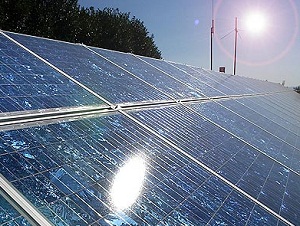Boeing brings space age solar to Earth
 Boeing’s Spectrolab is bringing space-age science down to Earth with its impending release of hyper-efficient photovoltaic solar cells made of germanium rather than the traditional silicon.
Boeing’s Spectrolab is bringing space-age science down to Earth with its impending release of hyper-efficient photovoltaic solar cells made of germanium rather than the traditional silicon.
The new solar cell, when mass-produced, is 39.2 percent efficient. Some of the most efficient silicon solar cells on the market now are only 23 percent efficient.
Spectrolab has been keeping satellites and space stations in orbit with its solar cells for over 50 years, according to a press release from the company.
Spectrolab released its first terrestrial solar cells, called C3MJ, in 2009 and sold more than 2 million of them to solar panel manufacturers around the world, said Diana Ball, in Boeing’s Space and Intelligence Systems communications department.
“But Spectrolab keeps researching, and they keep pushing the envelope,” she said. “Every year they come out with a new number, and every year it’s higher than the last.”
Greater efficiency typically equates to greater cost in the solar industry. Ball said she couldn’t comment on how the cells will be priced, but that the price will ultimately be up to the panel manufacturers to determine.
While she said they are probably more expensive than traditional silicon cells, some buyers are willing to take the financial hit to know they’re getting the most efficient and reliable product.
Germanium is one of the rarer elements on Earth, according to a University of Utah report that says the close relative to silicon costs about $680 per pound. Silicon, the second most predominant element in the Earth’s core after oxygen, costs about $1.40, according to a report in Photon International.
Spectrolab announced earlier this year that it achieved 41.6 percent efficiency in one of its germanium solar cells, Ball said. The cell it’s preparing to mass produce now is spawned from that one, but loses some of its efficiency in the mass production process, Ball said.
Spectrolab expects that the panel manufacturers that bought its C3MJ series of cells will roll over into the newer, more-efficient model, according to the press release.
Spectrolab solar cells have powered satellites since 1958, according to the release, and currently power 60 percent of all satellites in space and the world space station.
The company expects to achieve a reliable 40 percent efficiency in the near future, Ball said. That’s nearly double the efficiency rating of the most efficient silicon solar cells on the market today.
Image courtesy of German-info.com.



